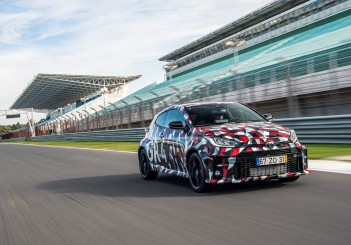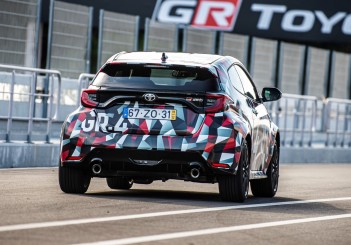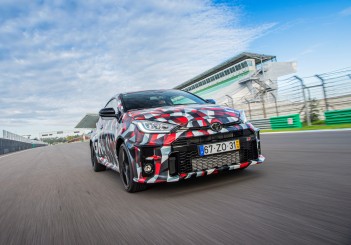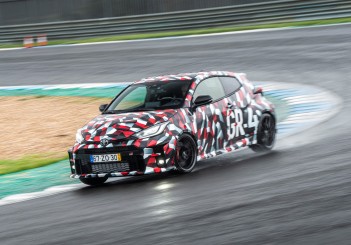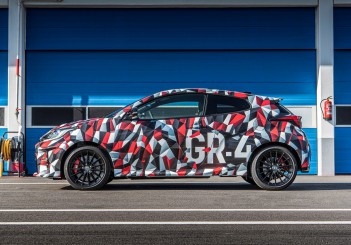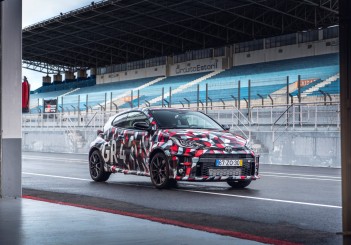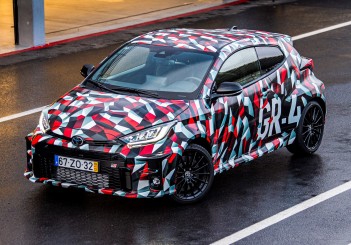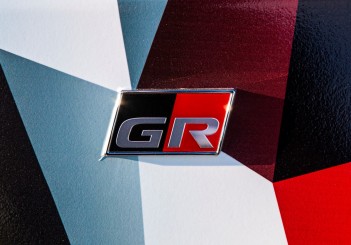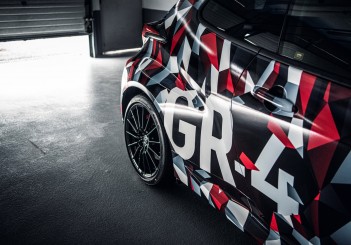The Toyota GR (Gazoo Racing) Yaris will be unveiled at the Japan Auto Salon on Jan 10. But first, we had the opportunity to drive it in a faraway place. Lisbon to be exact.
The Portuguese weather brought rain and cold winds on the day we were to try out the GR Yaris prototype on public roads and the track.

Covered in a camouflage wrap, the GR Yaris sat lower than usual with fatter tyres that ran almost flush with its bodywork.
Inside, the dashboard was mostly covered up, and members of the media were advised not to publish photos showing the interior of the car.
Toyota apparently wanted to save some surprises for launch day.
Under the hood lies a 1.6-litre turbocharged engine mated to a six-speed manual transmission.
What’s unique about the powerplant is that it’s got three-cylinders only.
Before the scoffing starts, Toyota will have you know that its “little” engine is capable of out over 250hp and 350Nm of torque.
Within the GR Yaris' core are some special mechanicals to boost its performance.

The three-door car is equipped with two Torsen limited-slip differentials (LSDs) — each mounted on an axle and ready to distribute power between the front and rear accordingly depending on what’s been selected — Normal (60:40), Sport (30:70) and Track (50:50).
The drive modes do not affect the car in any other way, unlike in some other systems which can control throttle mapping, exhaust note, steering heft, suspension or traction control.
The car comes with serious stopping power; it’s fitted with enlarged grooved brake discs with a four-pot calliper in front and two-pot at the back.
The brakes are partially hidden by a set of lightweight 18-inch gloss-black 15-spoke Enkei wheels with 225/40 Michelin Pilot Sport 4S tyres.
However, there is a non-performance GR Yaris that doesn’t have the LSD and uses Dunlop SP Sport Maxx 050 tyres instead.

For greater stability, the Yaris’ standard rear torsion beam suspension has been replaced with a more sophisticated double-wishbone setup.
Professional drivers from Tommi Makinen Racing (TMR) team helped develop the GR Yaris.
You may remember Makinen as one of the most accomplished World Rally Championship (WRC) driver from Finland who helped take Mitsubishi’s Lancer Evolution 3 to 6.5 rally cars to great success from 1996 to 2001.
Currently, his team uses a Yaris WRC car under the GR flag that’s been equipped with a 1.6-litre turbocharged direct-injection engine making a whopping 350hp-plus.

During its development, the GR Yaris was made into a lightweight all-wheel-drive hatch with optimised weight distribution.
This was achieved by moving the engine rearwards while using weight-saving aluminium body panels and a carbon fibre reinforced plastic (CFRP) roof that’s been lowered for better aerodynamics.
The front end is flanked by gaping holes for brake-cooling duties and the front vents have been made far more “air-ccessible” for the radiator and intercooler.
The seating position was, alas, not as adjustable as I had wanted. The seat didn’t allow itself to be lowered more to fit the frame of this 176cm-tall writer, who had to put up with driving about with the rearview mirror stuck in his line of sight.

Furthermore, the space between the accelerator and brake pedal was oddly far apart, which hampered heel-and-toe movements.
Out on the roads, in and around Lisbon, our 50km journey took us to Cabo Da Roca (Cape Rock) - the most Western point of the European continent that meets the Atlantic Ocean.
En route, the ride was compliant over stretches of uneven surfaces. One can’t expect much comfort from stiffened suspension with large 18-inch wheels on low profile tyres.
For the most part, we did not manage to push the car hard as a downpour soon ensued shortly after the journey began.
Nevertheless, we discovered that the GR Yaris was quite docile when driven normally.

We dare say this is a liveable hot hatch that even the most novice of drivers can steer if one is not opposed to towing through gears manually.
The throws of the six-speeder was a tad long but were smooth and easy to operate.
The steering felt taut for that sporty feel and wasn’t excessively heavy.
But the real surprise was how well insulated the cabin was, with a non-intrusive exhaust note that only announced its presence when the engine gets riled up from 3,000rpm onwards.
It manages to handle directional changes like a champ with a rather subservient rear end — all this while in Track mode, where the perception of grip could be keenly felt.
Punching the throttle will properly stick occupants into their seats. Revving the engine towards its 7,000rpm redline will have it seemingly run out of breath around the 6,000rpm mark.

From Cape Rock, we made our way to the Circuito do Estoril — the country’s former Formula One track from 1984 to 1996.
There, we managed to provide the GR Yaris with some proper thrashing and compare it to the non-performance GR Yaris as well.
Out on the well-drenched 4.182km track, it was found that both variants provide almost equal amounts of fun.
If there were anything to tell them apart, it would be that the non-performance variant was prone to deliver fun tail-wagging moments during excessive throttle inputs due to the lack of the LSDs and the less-grippy Dunlops.
Aside from those, the brakes performed admirably and lacked an abrupt initial bite that would usually put drivers in a nervous state.
Rather, pedal input and the amount of bite from the big brakes were highly consistent and there was hardly any brake fade even after five hard laps in both variants.

Also, nose-diving under heavy braking was minimised, more so for the performance variant with about 10% of torque being sent to its rear LSD to help “sit” the rear end down a little and prevent it from wagging.
Overall, the experience was great fun.
But why is Toyota building a hot hatch? So that it can go racing in the WRC, of course. One of the requirements is that the company build some 25,000 examples of a road-going version to qualify for WRC entry.
Bear in mind the GR Yaris is a prototype that’s 80% complete.
From what we’ve been allowed to tell, Malaysia should be receiving some 100 units of this magnificent hatch by 2021. So start saving up for this little marvel.




























